| Term |
Source |
Meaning |
Illustration |
| Tank Military |
Windsor Regiment, RCAC (Badge) Vol IV, P 425 |
 The Tank shown in this badge is of First World War vintage. It represents the Regiment's origins as a tank unit, formed in 1936. The Tank shown in this badge is of First World War vintage. It represents the Regiment's origins as a tank unit, formed in 1936. |
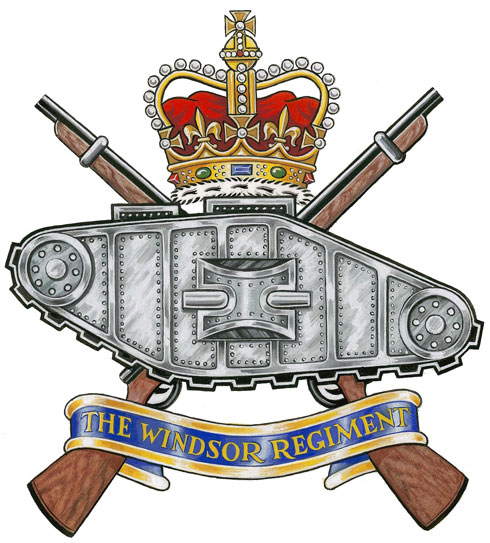 |
| Tapissé |
Cadet SU (Prairie) |
 Tapissé means carpeted. In the badge shown, the background of the base is blazoned as “tapissé of wheat Or". Tapissé means carpeted. In the badge shown, the background of the base is blazoned as “tapissé of wheat Or". |
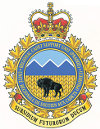 |
| Tarascan Feathered Coronet |
Macouzet, M. Vol V, P 553 |
 The feathered coronet represents the State of Tarascan in pre-Columbian Mexico. The feathered coronet represents the State of Tarascan in pre-Columbian Mexico. |
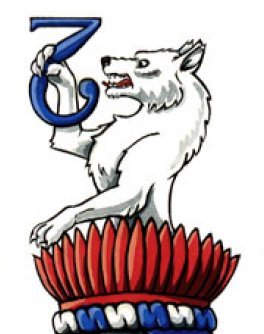 |
| Teapot |
Murchie's Tea and Coffee, Ltd. Vol II, P230 |
 The Teapot, used here for the first time in heraldry, is a familiar household utensil. It obviously refers to the grantee's business. The Teapot, used here for the first time in heraldry, is a familiar household utensil. It obviously refers to the grantee's business. |
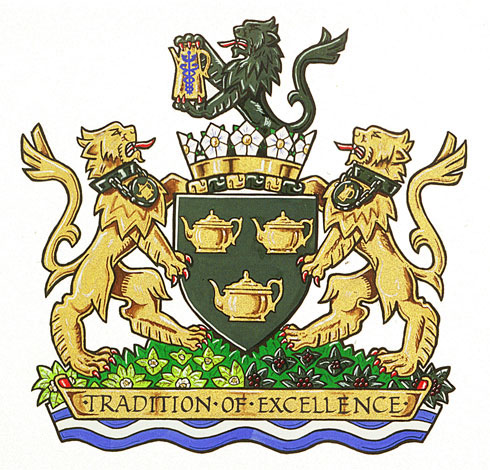 |
| Terpsichore |
Centre Uriel. Vol V, P 478 |
 Terpsichore is the classsical muse of dance. Her image is used here to refer to the Centre Uriel’s role as an organization devoted to training for the dance. Terpsichore is the classsical muse of dance. Her image is used here to refer to the Centre Uriel’s role as an organization devoted to training for the dance. |
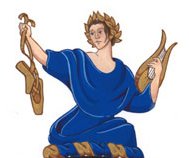 |
| Thorn Branch |
Silverthorn, G. (Crest) Vol IV, P 307 |
 The Thorn Branch argent held by the cougar in this crest is a canting reference to the grantee’s surname. The Thorn Branch argent held by the cougar in this crest is a canting reference to the grantee’s surname. |
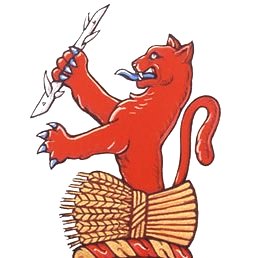 |
| Threaded Needle |
Lindala, G.J. Vol III, P 322 |
 The Threaded Needle refers to the fact that the grantee's grandfather was a tailor in Finland, his country of origin. The Threaded Needle refers to the fact that the grantee's grandfather was a tailor in Finland, his country of origin. |
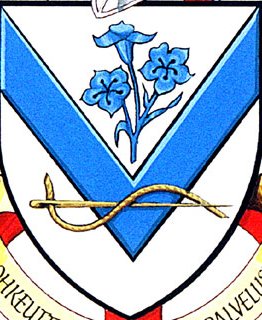 |
| Thunderbird |
Abbottsford |
This is a traditional mythological creature used by the Haida and other West-coast aboriginal tribes. It resembles an eagle, and is sometimes depicted as double-headed. |
 |
| Thunderbird #2 |
Military Police Branch. Vol V, P 545 |
 In the mythology of the First Nations, the thunderbird is a symbol of supremacy and power. It is also a protective spirit, one who gives wise counsel and guards the community against evil and misfortune. In the mythology of the First Nations, the thunderbird is a symbol of supremacy and power. It is also a protective spirit, one who gives wise counsel and guards the community against evil and misfortune. |
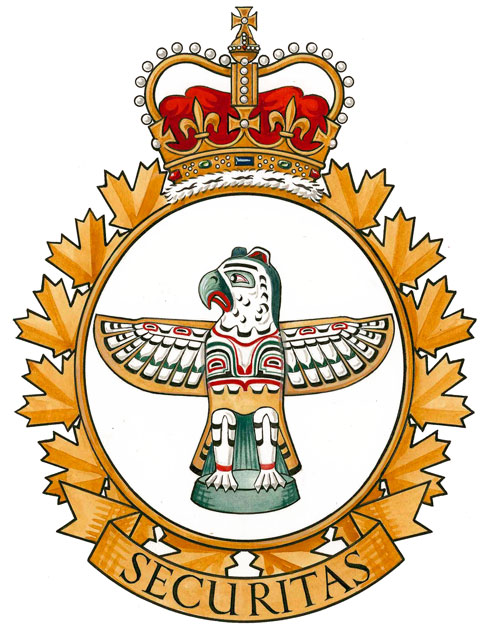 |
| Thurible |
Duffy, I.R. Vol VI, P 92 |
 The Thurible blazoned in this Catholic Priest's arms is perhaps better known as an incense burner. The Thurible blazoned in this Catholic Priest's arms is perhaps better known as an incense burner. |
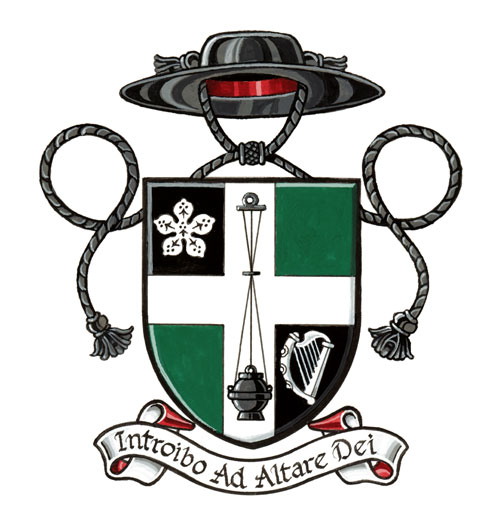 |
| Timber Wolf |
Bloomfield, H.J.F. Vol II, P 323 |
 The Timber Wolf is a medium-sized wolf found mainly in the country north-east of the Great Lakes. Like all wolves, it is a carnivore, its prey mainly deer and beaver. Heraldically, it symbolizes strength, agility and determination. The Timber Wolf is a medium-sized wolf found mainly in the country north-east of the Great Lakes. Like all wolves, it is a carnivore, its prey mainly deer and beaver. Heraldically, it symbolizes strength, agility and determination. |
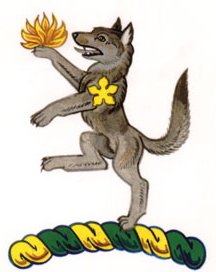 |
| Tipstaff |
Ontario Provincial Police Commissioner. (Badge) Vol III, P 237 |
 The Tipstaff is a ceremonial baton carried by an important individual on ceremonial occasions. In this case, it represents specifically the baton of the OPP Commissioner. The Tipstaff is a ceremonial baton carried by an important individual on ceremonial occasions. In this case, it represents specifically the baton of the OPP Commissioner. |
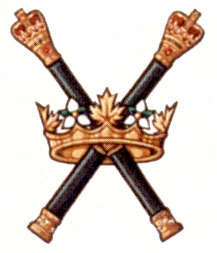 |
| Tlingit Copper Shield |
Gingell, J. Vol III, P 272 |
 The supporter behind the arms is a depiction of a copper shield of the Tlingit First Nation from the Pacific Northwest. It was a symbol of wealth and status. The supporter behind the arms is a depiction of a copper shield of the Tlingit First Nation from the Pacific Northwest. It was a symbol of wealth and status. |
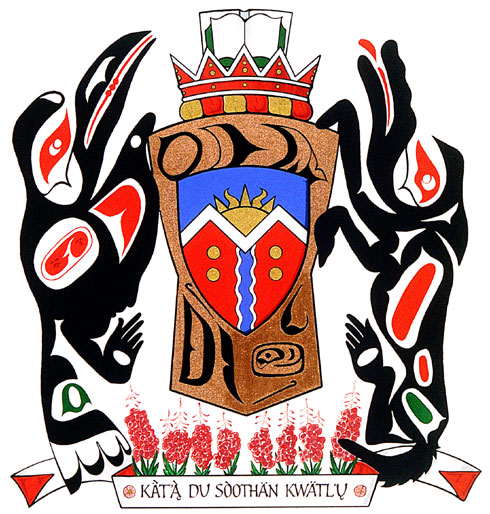 |
| Tomahawk |
Canadian Forces War of 1812 Commemorative Banner. Vol VI, P 72 |
 The Tomahawks are used in this context to represent the First Nation allies in the War of 1812. The Tomahawks are used in this context to represent the First Nation allies in the War of 1812. |
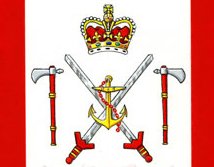 |
| Tomoes |
Yamanaka, R.M. Vol V, P 86 |
 The three swirling drops known as the Tomoes are the emblem of Okinawa, alluding to the grantee's heritage. The three swirling drops known as the Tomoes are the emblem of Okinawa, alluding to the grantee's heritage. |
 |
| Tongs (Blacksmith's) |
University of P.E.I. (Flag) Vol V, P 503 |
 The Blacksmith’s tongs (shown in the dexter chief along with mallets) are a reference to St. Dunstan, the patron saint of blacksmiths. St. Dunstan’s University joined with Prince of Wales College to form the University of P.E.I. The Blacksmith’s tongs (shown in the dexter chief along with mallets) are a reference to St. Dunstan, the patron saint of blacksmiths. St. Dunstan’s University joined with Prince of Wales College to form the University of P.E.I. |
 |
| Torah Crown |
Abraham |
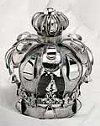 The Torah Crown is a reference to the Jewish faith. However, the one depicted in the grant illustrated does not seem to resemble the traditional torah crown, which typically has a sort of cupola at the top (see image on right). The Torah Crown is a reference to the Jewish faith. However, the one depicted in the grant illustrated does not seem to resemble the traditional torah crown, which typically has a sort of cupola at the top (see image on right). |
 |
| Torah Crown #2 |
Wosk, M.J. Vol IV, P 299 |
 The Torah Crown is a Hebrew emblem, referring to the Tribe of Levi. It displays a Mogen (or Star of) David in its centre. It is used heraldically to refer to the traditions of Judaism. The Torah Crown is a Hebrew emblem, referring to the Tribe of Levi. It displays a Mogen (or Star of) David in its centre. It is used heraldically to refer to the traditions of Judaism. |
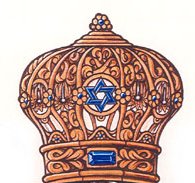 |
| Torah Scroll |
Congregation of Shaar Hashomayim. Vol III, P 45 |
 The Torah symbolizes the law that forms the basis of Judaism. The Torah symbolizes the law that forms the basis of Judaism. |
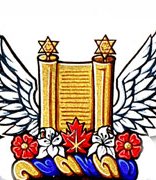 |
| Train |
Sainte-Foy |
The blazon reads "... a bend Or charged with five kegs joined by a train Sable." Before one searches for a locomotive and several cars, it should be noted that the train here (in the ancient French arms of Brulard de Sillery) refers to a train of gunpowder or fuse arranged to cause an explosion, although this is not explained for the benefit of the artist. |
 |
| Treble Clef |
Hamilton Children's Choir |
 The treble clef is a musical symbol readily converted into an heraldic one, as depicted here. The treble clef is a musical symbol readily converted into an heraldic one, as depicted here. |
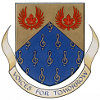 |
| Trellisé |
Tellier, L-N. Vol V, P 505 |
T he term Trellisé refers to a lattice-like pattern of interwoven bands or fibres. he term Trellisé refers to a lattice-like pattern of interwoven bands or fibres. |
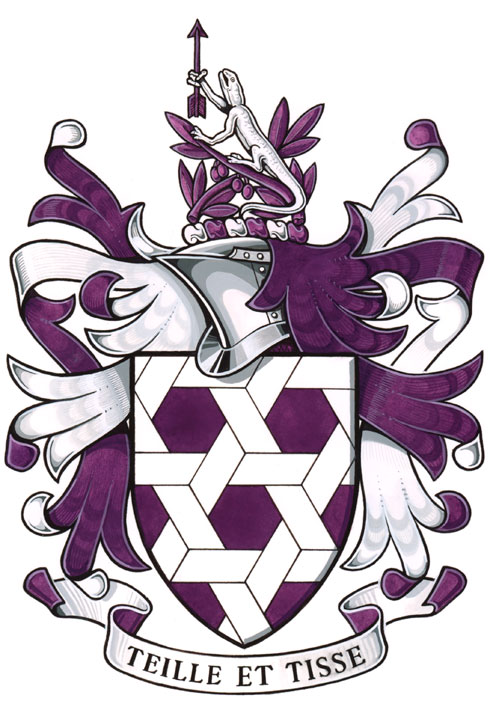 |
| Tressure Érablé |
|
A tressure embellished with maple leaves set alternately. |
 |
| Trian Aspect |
Prairie Gliding School |
This useful term, meaning "in three-quarter view" (between affronty and profile) is generally used for animals or persons. It serves a useful purpose here to refer to a ship. |
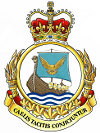 |
| Trillium, Red |
Waterdown/East Flamborough Heritage Society. Vol VI, P 43 |
 The Red Trillium (as shown in the compartment) is found in abundance in the Flamborough area. The Red Trillium (as shown in the compartment) is found in abundance in the Flamborough area. |
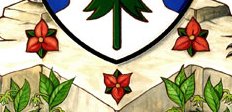 |
| Trillium, White - Heraldic |
Lindsay, R.A. (Badge) Vol VI, P 152 |
The White Trillium is the Provincial Flower of Ontario. |
 |
| Trillium, White - Natural |
Provincial Flowers of Canada |
 The White Trillium (shown here in its natural form) is the Provincial flower of Ontario. The White Trillium (shown here in its natural form) is the Provincial flower of Ontario. |
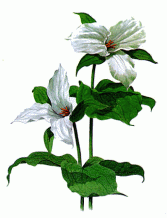 |
| Trilobite |
City of Percé, Quebec. Vol III P 194 |
The Trilobites (one shown here in base) are a fossil group of extinct marine arthropods. They were among the most successful of all early animals, flourishing until the mass extinction of the Devonian period. |
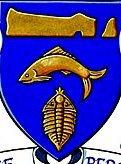 |
| Triquetra |
Hood, A.D. Vol III, P 231 |
 The Triquetra, as illustrated in the shield, is used as a symbol for the Trinity. The Triquetra, as illustrated in the shield, is used as a symbol for the Trinity. |
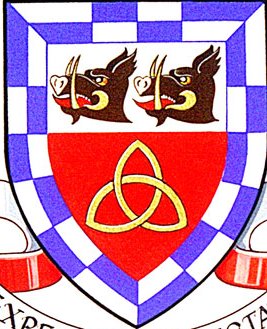 |
| Trout, Steelhead |
Town of Lake Cowichan, BC. Vol V, P 327 |
 The Steelhead Trout references the great fishing of the Cowichan area, for which the community is famous. The Steelhead Trout references the great fishing of the Cowichan area, for which the community is famous. |
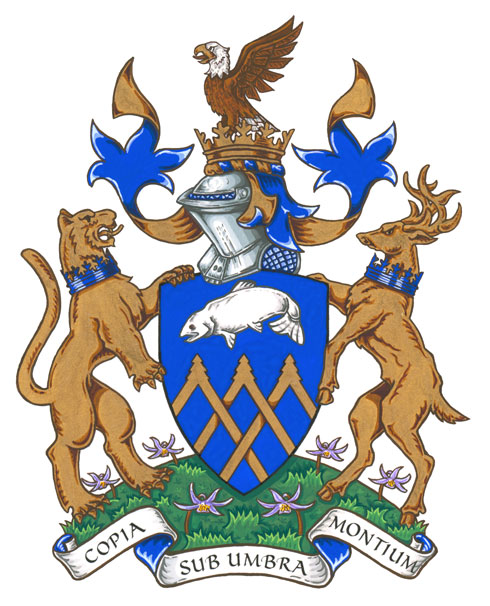 |
| Tryzub |
Steeves |
A common symbol of Ukraine. It is believed to have originated as a tribal symbol and is included in the country's flag. Used for Canadians of Ukrainian descent. |
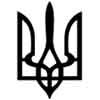 |
| Tsubouchi Mon |
Tsubouchi, D.H. Vol II, P 262 |
 The Mon is a Japanese emblem used to identify an individual or family. Their use is in many ways similar to that of European heraldry. Most usually, they consist of a roundel encircling a plant, animal, man-made or celestial object.
In the illustrated arms, there has been an interesting artistic effort to connect the Japanese grantee with his home in Canada. Each mon is composed of six single-winged maple-seeds conjoined, wings outward, and within an annulet Or - Canadian and Japanese heraldry combined. The Mon is a Japanese emblem used to identify an individual or family. Their use is in many ways similar to that of European heraldry. Most usually, they consist of a roundel encircling a plant, animal, man-made or celestial object.
In the illustrated arms, there has been an interesting artistic effort to connect the Japanese grantee with his home in Canada. Each mon is composed of six single-winged maple-seeds conjoined, wings outward, and within an annulet Or - Canadian and Japanese heraldry combined. |
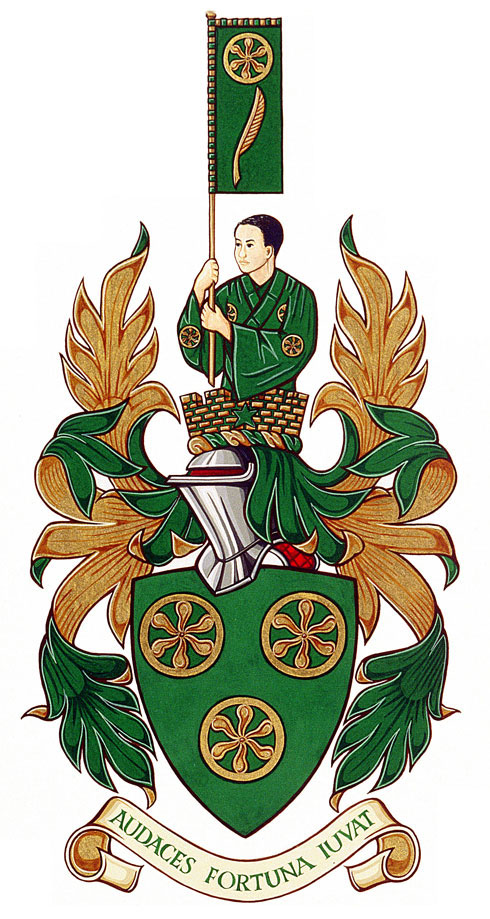 |
| Tulip Tree Leaf |
Norfolk County, Ontario. Vol IV, P 355 |
 The Tulip Tree (its leaves shown here in the chief) is a feature of the Carolinian Forrest, which extends into Southern Ontario. The name originates from the shape of the leaf. The Tulip Tree (its leaves shown here in the chief) is a feature of the Carolinian Forrest, which extends into Southern Ontario. The name originates from the shape of the leaf. |
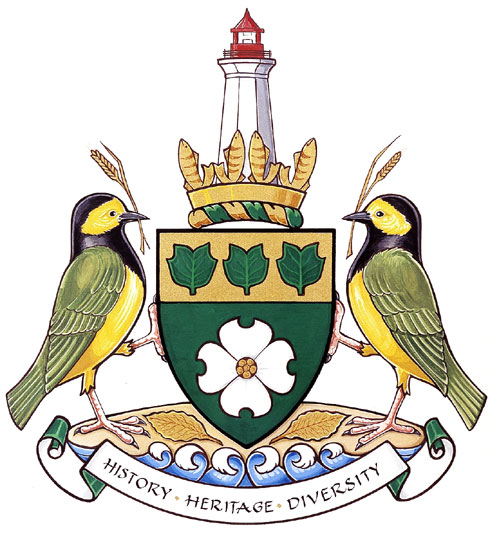 |
| Turtle Shell |
Nicholas, G. Vol VI, P 360 |
 The Turtle Shell, (seen here in the compartment), represents the Maliseet First Nation's Turtle Clan, and their conception of the world as supported on a turtle's back. The Turtle Shell, (seen here in the compartment), represents the Maliseet First Nation's Turtle Clan, and their conception of the world as supported on a turtle's back. |
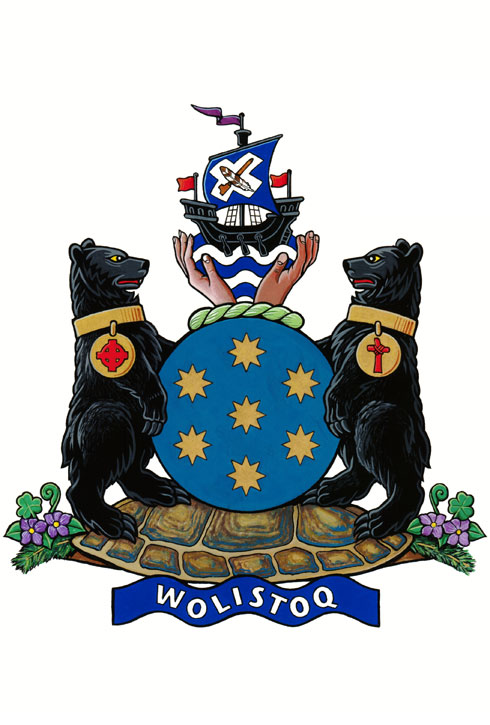 |
 Canadian Heraldic Dictionary
Canadian Heraldic Dictionary Canadian Heraldic Dictionary
Canadian Heraldic Dictionary
